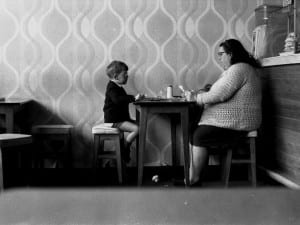The Body Extended: Sculpture and Prosthetics presents to the visitor a variety of exhibits – objects, images, artworks – representing work from the late 19th century to the present day. Within the context of Henry Moore Institute, the exhibition explores how sculpture and medical science have augmented the analogue human figure, functionally expanding its reach and power.
The representation of the expansion and multiplication of the human frame’s force and power from within this time period necessarily draws heavily on the direct and tangential experience of the impact of the atrocious human disasters in the first half of the twentieth century. The First and Second World Wars drove forward the technological advancement of prosthetics. So common was the use of prosthetics in being attached to ex-soldiers’ limbs and bodies with the use of braces after the First World War that the phrase “a bracing walk” fell out of polite usage as an insensitive and inconsiderate remark. The First World War was the first mass global war of the mass industrialised age, but fought primarily on a non-capital-intensive, but personnel-intensive basis. With human losses experienced on a massive scale between 1914 and 1918, the years following saw the mutilated body introduced significantly into public life. Both artists and surgeons sought to remake and refashion what had been lost.
The centrepiece of the exhibition can be found external to the gallery space mounted on a rudimentary bronze wheeled platform. Rebecca Warren’s Untitled (War Commission) stands outside HMI on The Headrow: Leeds’ busiest thoroughfare. In her own words, Warren describes the work as a “weighty, raw bronze, mainly of legs made of extreme convexities of muscle.” The work is an arresting and charismatic part-colossus engendering physical empathy via the modesty of the familiar, human contours, despite their exaggeration. An invocation of physical empathy traceable to such modest and familiar physical definition is an abiding impression of The Body Extended that transcends the entire exhibition.
The work of the surgeons sought to extend the limitations of the human body. The artists included here explored those extensions in tandem with both the synthesised and manufactured constraints revealed as physical limitations. This translates into commentary on the limitations and destructive flaws of human nature. As a reminder of the atrocious consequences of the inadequacy and flaws in human nature The Body Extended is a timely one given the general rise and encouragement of the fascistic tendencies across the globe.
Alongside examples of prostheses from the collections of the Freud Museum, Hunterian, Imperial War Museum and Leeds’ own Thackray Medical Museum, the visitor encounters the artwork of Louise Bourgeois, Rebecca Horn, and Matthew Barney. Prosthetics are central to these works. The care that has been taken by surgeons and artists to emulate accurately the weighting, measure, balance and modesty of the lost body parts is detectable as a conversely hopeful facet of humanity. This ray of optimism that comes as part and parcel of a body of evidence indicating gross fault is a moving overall impression that might not be made to outside the context of an art gallery.
Daniel Potts
The Body Extended runs until 23 October at the Henry Moore Institute. Find out more: www.henry-moore.org
Credits:
1. Rebecca Horn, Moveable Shoulder Extensions (1971). Courtesy of the Henry Moore Institute and Achim Thode. Rebecca Horn / DACS 2016.





